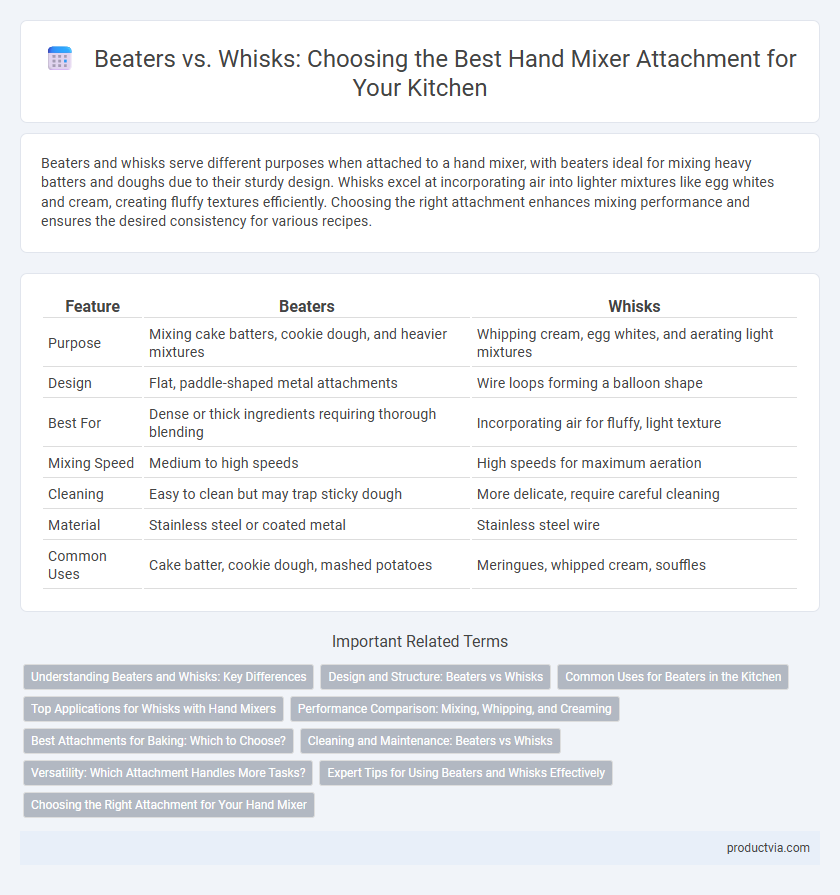Beaters and whisks serve different purposes when attached to a hand mixer, with beaters ideal for mixing heavy batters and doughs due to their sturdy design. Whisks excel at incorporating air into lighter mixtures like egg whites and cream, creating fluffy textures efficiently. Choosing the right attachment enhances mixing performance and ensures the desired consistency for various recipes.
Table of Comparison
| Feature | Beaters | Whisks |
|---|---|---|
| Purpose | Mixing cake batters, cookie dough, and heavier mixtures | Whipping cream, egg whites, and aerating light mixtures |
| Design | Flat, paddle-shaped metal attachments | Wire loops forming a balloon shape |
| Best For | Dense or thick ingredients requiring thorough blending | Incorporating air for fluffy, light texture |
| Mixing Speed | Medium to high speeds | High speeds for maximum aeration |
| Cleaning | Easy to clean but may trap sticky dough | More delicate, require careful cleaning |
| Material | Stainless steel or coated metal | Stainless steel wire |
| Common Uses | Cake batter, cookie dough, mashed potatoes | Meringues, whipped cream, souffles |
Understanding Beaters and Whisks: Key Differences
Beaters for hand mixers are designed with flat, paddle-like blades that efficiently mix dense ingredients such as cookie dough or cake batter, ensuring thorough blending without overworking the mixture. Whisks feature thin, wire loops that incorporate air into lighter ingredients like egg whites or cream, achieving fluffy, voluminous textures. Understanding the key differences between beaters and whisks helps optimize mixing results by matching the attachment to specific cooking tasks.
Design and Structure: Beaters vs Whisks
Beaters for hand mixers feature flat, paddle-like blades designed to thoroughly mix dense ingredients such as dough and batter by incorporating air and ensuring even consistency. Whisks have a balloon-shaped wire design optimized for whipping and aerating lighter mixtures like egg whites and cream, promoting maximum volume with minimal effort. The structural differences influence efficiency: beaters provide strong mixing power for heavy tasks, while whisks deliver gentle, rapid aeration essential for delicate textures.
Common Uses for Beaters in the Kitchen
Beaters are essential hand mixer attachments designed primarily for mixing dense ingredients such as cookie dough, cake batter, and mashed potatoes. Their flat, paddle-like shape efficiently combines heavy mixtures, ensuring even texture and thorough blending. Common kitchen tasks that require beaters include creaming butter and sugar, whipping thick batters, and mixing frostings.
Top Applications for Whisks with Hand Mixers
Whisk attachments for hand mixers excel at incorporating air into mixtures, making them ideal for whipping cream, beating egg whites to stiff peaks, and creating light, fluffy meringues. They are also perfect for blending batters that require aeration, such as sponge cakes and mousses. These attachments deliver consistent, smooth results by efficiently combining ingredients without overmixing.
Performance Comparison: Mixing, Whipping, and Creaming
Beaters for hand mixers excel in creaming and mixing dense ingredients like butter and sugar, providing efficient aeration and smooth batter consistency. Whisks outperform beaters in whipping tasks, rapidly incorporating air into egg whites and cream for light, fluffy textures. Choosing between beaters and whisks depends on the specific task, as beaters handle heavier mixtures while whisks specialize in creating volume and airy results.
Best Attachments for Baking: Which to Choose?
Beaters are ideal for heavy-duty mixing tasks such as creaming butter and sugar or mixing cake batters, offering robust performance for dense ingredients. Whisks excel at whipping air into lighter mixtures like egg whites or cream, creating smooth, fluffy textures essential for meringues and mousses. Choosing the right hand mixer attachment depends on the baking task: use beaters for thick batters and whisks for aerating and lightening mixtures.
Cleaning and Maintenance: Beaters vs Whisks
Beaters for hand mixers typically have fewer crevices and larger surfaces, making them easier and faster to clean compared to whisks that feature multiple thin wires trapping more batter or dough residue. Whisks often require more thorough scrubbing or soaking to remove stuck-on ingredients, increasing maintenance time and effort. Stainless steel beaters usually resist rust and staining better, enhancing durability and simplifying cleaning routines.
Versatility: Which Attachment Handles More Tasks?
Beaters provide superior versatility for hand mixers, efficiently handling tasks such as mixing batters, mashing potatoes, and blending thicker ingredients. Whisks excel primarily at incorporating air into mixtures, making them ideal for whipping cream and egg whites but less effective for dense or heavy mixtures. For users seeking an attachment that addresses a wider range of culinary tasks, beaters deliver more comprehensive functionality.
Expert Tips for Using Beaters and Whisks Effectively
Beaters excel at mixing heavy doughs and batters because their flat blades efficiently combine dense ingredients, while whisks are ideal for incorporating air into lighter mixtures like egg whites and cream. Experts recommend using beaters for cookie dough or cake batter to achieve a smooth consistency and switching to whisks for meringues and whipped cream to maximize volume and texture. Maintaining clean, rust-free attachments and selecting the correct speed setting based on attachment type enhances performance and extends the lifespan of hand mixer tools.
Choosing the Right Attachment for Your Hand Mixer
Beaters are ideal for mixing dense ingredients like cookie dough or cake batter, providing thorough blending and even consistency. Whisks excel at incorporating air into lighter mixtures such as egg whites or cream, ensuring a fluffy and smooth texture. Selecting the right attachment for your hand mixer enhances performance and achieves optimal results based on the specific cooking task.
Beaters vs Whisks for Hand Mixer Attachments Infographic

 productvia.com
productvia.com